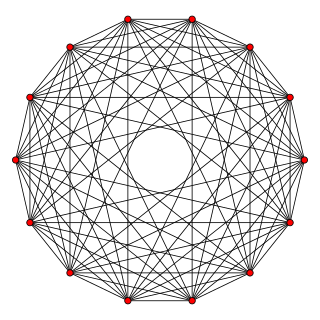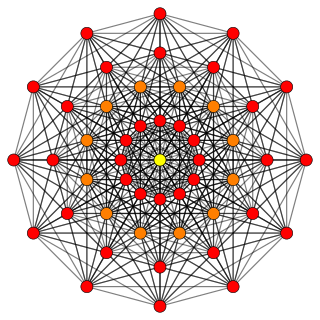 W
WIn 7-dimensional geometry, 132 is a uniform polytope, constructed from the E7 group.
 W
WIn 7-dimensional geometry, 231 is a uniform polytope, constructed from the E7 group.
 W
WIn 7-dimensional geometry, the 321 polytope is a uniform 7-polytope, constructed within the symmetry of the E7 group. It was discovered by Thorold Gosset, published in his 1900 paper. He called it an 7-ic semi-regular figure.
 W
WIn geometry, a 7-cube is a seven-dimensional hypercube with 128 vertices, 448 edges, 672 square faces, 560 cubic cells, 280 tesseract 4-faces, 84 penteract 5-faces, and 14 hexeract 6-faces.
 W
WIn geometry, a demihepteract or 7-demicube is a uniform 7-polytope, constructed from the 7-hypercube (hepteract) with alternated vertices removed. It is part of a dimensionally infinite family of uniform polytopes called demihypercubes.
 W
WIn geometry, a 7-orthoplex, or 7-cross polytope, is a regular 7-polytope with 14 vertices, 84 edges, 280 triangle faces, 560 tetrahedron cells, 672 5-cells 4-faces, 448 5-faces, and 128 6-faces.
 W
WIn 7-dimensional geometry, a 7-simplex is a self-dual regular 7-polytope. It has 8 vertices, 28 edges, 56 triangle faces, 70 tetrahedral cells, 56 5-cell 5-faces, 28 5-simplex 6-faces, and 8 6-simplex 7-faces. Its dihedral angle is cos−1(1/7), or approximately 81.79°.
 W
WIn 7-dimensional geometry, there are 71 uniform polytopes with A7 symmetry. There is one self-dual regular form, the 7-simplex with 8 vertices.
 W
WIn 7-dimensional geometry, there are 128 uniform polytopes with B7 symmetry. There are two regular forms, the 7-orthoplex, and 8-cube with 14 and 128 vertices respectively. The 7-demicube is added with half of the symmetry.
 W
WIn seven-dimensional geometry, a cantellated 7-cube is a convex uniform 7-polytope, being a cantellation of the regular 7-cube.
 W
WIn seven-dimensional geometry, a cantellated 7-orthoplex is a convex uniform 7-polytope, being a cantellation of the regular 7-orthoplex.
 W
WIn seven-dimensional geometry, a cantellated 7-simplex is a convex uniform 7-polytope, being a cantellation of the regular 7-simplex.
 W
WIn seven-dimensional geometry, a cantic 7-cube or truncated 7-demicube as a uniform 7-polytope, being a truncation of the 7-demicube.
 W
WIn 7-dimensional geometry, there are 95 uniform polytopes with D7 symmetry; 32 are unique, and 63 are shared with the B7 symmetry. There are two regular forms, the 7-orthoplex, and 7-demicube with 14 and 64 vertices respectively.
 W
WIn 7-dimensional geometry, there are 127 uniform polytopes with E7 symmetry. The three simplest forms are the 321, 231, and 132 polytopes, composed of 56, 126, and 576 vertices respectively.
 W
WIn seven-dimensional geometry, a hexic 7-cube is a convex uniform 7-polytope, constructed from the uniform 7-demicube. There are 16 unique forms.
 W
WIn seven-dimensional geometry, a hexicated 7-cube is a convex uniform 7-polytope, including 6th-order truncations (hexication) from the regular 7-cube.
 W
WIn seven-dimensional geometry, a hexicated 7-orthoplex is a convex uniform 7-polytope, including 6th-order truncations (hexication) from the regular 7-orthoplex.
 W
WIn seven-dimensional geometry, a hexicated 7-simplex is a convex uniform 7-polytope, including 6th-order truncations (hexication) from the regular 7-simplex.
 W
WIn seven-dimensional geometry, a pentellated 7-cube is a convex uniform 7-polytope with 5th order truncations (pentellation) of the regular 7-cube. There are 32 unique pentellations of the 7-cube with permutations of truncations, cantellations, runcinations, and sterications. 16 are more simply constructed relative to the 7-orthoplex.
 W
WIn seven-dimensional geometry, a pentellated 7-orthoplex is a convex uniform 7-polytope with 5th order truncations (pentellation) of the regular 7-orthoplex.
 W
WIn seven-dimensional geometry, a pentellated 7-simplex is a convex uniform 7-polytope with 5th order truncations (pentellation) of the regular 7-simplex.
 W
WIn seven-dimensional geometry, a pentic 7-cube is a convex uniform 7-polytope, related to the uniform 7-demicube. There are 8 unique forms.
 W
WIn seven-dimensional geometry, a rectified 7-simplex is a convex uniform 7-polytope, being a rectification of the regular 7-simplex.
 W
WIn seven-dimensional geometry, a runcic 7-cube is a convex uniform 7-polytope, related to the uniform 7-demicube. There are 2 unique forms.
 W
WIn seven-dimensional geometry, a runcinated 7-cube is a convex uniform 7-polytope with 3rd order truncations (runcination) of the regular 7-cube.
 W
WIn seven-dimensional geometry, a runcinated 7-orthoplex is a convex uniform 7-polytope with 3rd order truncations (runcination) of the regular 7-orthoplex.
 W
WIn seven-dimensional geometry, a runcinated 7-simplex is a convex uniform 7-polytope with 3rd order truncations (runcination) of the regular 7-simplex.
 W
WIn seven-dimensional geometry, a stericated 7-cube is a convex uniform 7-polytope, being a runcination of the uniform 7-demicube. There are 4 unique runcinations for the 7-demicube including truncation and cantellation.
 W
WIn seven-dimensional geometry, a stericated 7-cube is a convex uniform 7-polytope with 4th order truncations (sterication) of the regular 7-cube.
 W
WIn seven-dimensional geometry, a stericated 7-orthoplex is a convex uniform 7-polytope with 4th order truncations (sterication) of the regular 7-orthoplex.
 W
WIn seven-dimensional geometry, a stericated 7-simplex is a convex uniform 7-polytope with 4th order truncations (sterication) of the regular 7-simplex.
 W
WIn seven-dimensional geometry, a truncated 7-orthoplex is a convex uniform 7-polytope, being a truncation of the regular 7-orthoplex.
 W
WIn seven-dimensional geometry, a truncated 7-simplex is a convex uniform 7-polytope, being a truncation of the regular 7-simplex.
 W
WIn seven-dimensional geometry, a 7-polytope is a polytope contained by 6-polytope facets. Each 5-polytope ridge being shared by exactly two 6-polytope facets.